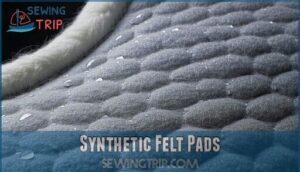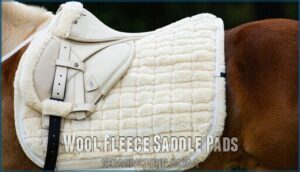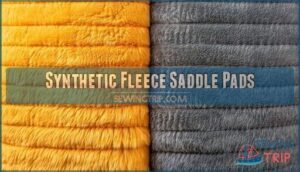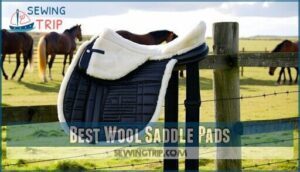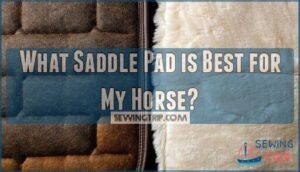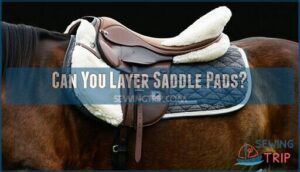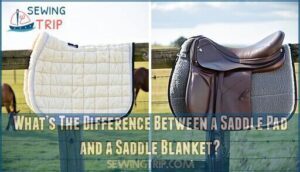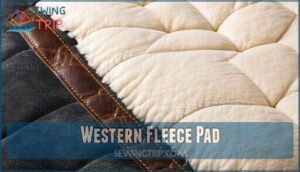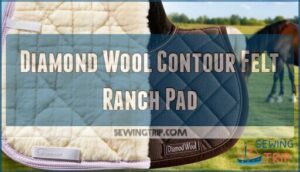This site is supported by our readers. We may earn a commission, at no cost to you, if you purchase through links.
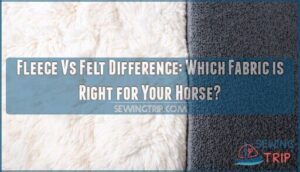 The fleece vs felt difference comes down to construction and performance.
The fleece vs felt difference comes down to construction and performance.
You’ll find fleece made from synthetic or natural fibers with a lofty, breathable structure that wicks moisture away from your horse’s back.
Felt, however, is compressed wool fibers creating a dense, shock-absorbing material.
Fleece excels at temperature regulation and dries quickly, making it perfect for sweaty horses or frequent washing.
Felt provides superior pressure distribution and durability, maintaining its shape ride after ride.
While fleece pads are lighter and more affordable, felt pads offer traditional performance that experienced riders trust.
The choice between materials affects your horse’s comfort in surprising ways.
Table Of Contents
- Key Takeaways
- Difference Between Fleece and Felt Fabric
- Fleece Vs Felt Saddle Pad
- Best Wool Saddle Pads
- What Saddle Pad is Best for My Horse?
- Can You Layer Saddle Pads?
- What’s The Difference Between a Saddle Pad and a Saddle Blanket?
- Challenger Quilted Padded Horse Saddle Pad Blue
- Western Fleece Pad
- Diamond Wool Contour Felt Ranch Pad
- Frequently Asked Questions (FAQs)
- Conclusion
Key Takeaways
- You’ll get better moisture management with fleece – it wicks sweat away from your horse’s back and dries quickly, making it perfect for active horses or frequent washing, while felt absorbs moisture and takes longer to dry.
- Felt provides superior shock absorption and pressure distribution – the compressed wool fibers create a dense material that protects your horse’s back better than fleece’s lighter, more flexible structure.
- Fleece wins for easy maintenance and durability – you can machine wash it without worry and it maintains its shape ride after ride, while felt requires special care and can lose its form over time.
- Your choice depends on your riding style and horse’s needs – fleece works best for frequent riders in hot climates who need easy care, while felt suits riders prioritizing maximum comfort and pressure relief for their horses.
Difference Between Fleece and Felt Fabric
When choosing between fleece and felt, you’re looking at two fabrics that couldn’t be more different in their makeup and performance.
Two fabrics, worlds apart – fleece flows like air while felt stands firm as stone.
Material Origin sets them apart immediately. Fleece comes from polyester plastic, while felt originates from compressed wool fibers or synthetic materials.
This fabric comparison reveals why their properties differ so dramatically.
Texture Comparison shows fleece’s soft, lightweight feel versus felt’s dense, firm structure. Fleece fabric offers flexibility and breathability, making it comfortable against skin.
Felt fabric provides superior insulation but feels stiffer and heavier.
Fabric Durability favors fleece for everyday use. It withstands frequent washing and maintains its shape well.
Felt, however, can lose its form over time and requires careful handling.
Cleaning Methods make fleece the clear winner for maintenance. You can machine wash fleece easily, while felt needs special care to prevent damage and moth attraction.
Common Uses reflect these differences – fleece dominates clothing and blankets, while felt excels in crafts and structured applications.
Fleece Vs Felt Saddle Pad
When you’re choosing between fleece and felt saddle pads, you’ll find that felt pads excel at wicking moisture and absorbing heat to keep your horse dry and cool.
Fleece pads offer durability and cost savings, but they require proper care to prevent the synthetic fibers from breaking down over time.
Synthetic Felt Pads
Modern synthetic felt pads revolutionize horse care through advanced polyester fiber construction.
These synthetic alternatives offer superior pad durability compared to traditional materials.
The needle punching manufacturing process creates consistent thickness and uniform fiber distribution.
As all artificial felts are produced using needle-felting techniques, they offer consistent quality.
| Feature | Synthetic Felt | Traditional Felt | Cost Impact |
|---|---|---|---|
| Maintenance Needs | Machine washable | Hand cleaning only | 60% time savings |
| Horse Comfort | Consistent cushioning | Variable softness | Better performance |
| Fabric Comparison | Moisture-resistant | Absorbs moisture | Longer lifespan |
Synthetic fabrics excel in felt properties like compression resistance.
Cost comparison shows synthetic felt pads deliver exceptional value through reduced maintenance requirements and enhanced durability.
Wool Fleece Saddle Pads
In terms of superior equine comfort, wool fleece saddle pads stand out as the gold standard.
These natural fiber pads deliver exceptional moisture-wicking capabilities, absorbing up to 30% of their weight without feeling wet.
Your horse stays dry and comfortable during extended rides.
Wool fleece benefits include superior temperature regulation and natural antimicrobial properties that reduce bacterial growth.
The breathable fleece fabric prevents heat buildup while providing excellent shock absorption compared to synthetic alternatives.
For sensitive skinned horses, consider that alpaca wool is soft and provides cooling.
| Feature | Wool Fleece Performance |
|---|---|
| Moisture Management | Absorbs 30% weight capacity |
| Temperature Control | Natural regulation system |
| Durability Rating | Multi-season longevity |
Fleece pad durability makes these investments last multiple riding seasons with proper wool cleaning methods.
While maintenance requires specialized care, the superior comfort and performance make wool fleece the preferred choice for discerning riders prioritizing their horse’s well-being over synthetic options.
The natural fiber and breathable nature of wool fleece pads contribute to their popularity among horse owners.
With proper care, these pads can provide years of comfortable riding.
Synthetic Fleece Saddle Pads
Synthetic fleece saddle pads offer budget-friendly performance for everyday riders.
Made from polyester synthetic fibers, these pads provide decent horse comfort while maintaining excellent fleece durability.
The synthetic fabric resists odors and offers quick-drying properties, though synthetic breathability falls short compared to natural alternatives.
You can find a synthetic fleece pad for various equestrian needs.
| Feature | Synthetic Fleece | Performance Rating |
|---|---|---|
| Cost Comparison | Most affordable | Excellent |
| Cleaning Methods | Machine washable | Very easy |
| Moisture Management | Quick-drying | Good |
These synthetic fabric options work well for casual riding.
The fleece fabric construction provides adequate cushioning, while felt fabric alternatives offer superior moisture-wicking.
Your saddle pad choice depends on budget and riding frequency.
Best Wool Saddle Pads
Premium wool saddle pads deliver unmatched performance through superior moisture wicking and natural comfort properties.
The Diamond Wool Rancher Pad stands out with 92% virgin wool content and 19 color options in multiple sizes. Five Star Equine Products offers exceptional durability factors with their 100% wool felt construction.
Professional’s Choice provides reliable wool benefits through their premium blend options. These pads maintain proper pad thickness while naturally molding to your horse’s back.
Consider browsing for specialized saddle padding for ideal fit. Unlike synthetic fleece alternatives, quality wool felt saddle pads range from $99-$150 and provide lasting comfort.
Quality wool felt saddle pads are a superior choice, offering natural comfort and durability. They are made from 100% wool felt construction, which ensures they remain effective over time.
What Saddle Pad is Best for My Horse?
Finding the perfect saddle pad starts with understanding your horse’s unique needs.
Your choice depends on several key factors that directly impact your horse’s comfort and performance.
Consider these essential elements when selecting your saddle pad:
- Horseback Riding Style – Trail riders need different padding than competitive ropers or barrel racers
- Horses Workload – Heavy work requires thicker, more shock-absorbing materials like wool felt
- Climate Considerations – Hot climates benefit from breathable wool, while synthetic fleece works well in cooler conditions
- Saddle Fit – A well-fitted saddle matters more than expensive padding materials
- Budget Options – Quality synthetic materials often perform as well as premium natural fibers
Wool felt provides superior pressure distribution and moisture-wicking properties.
It’s dense, non-absorbent, and protects sensitive pressure points effectively.
Synthetic fleece offers affordability and easy maintenance but may bunch under the saddle during intense rides.
Many riders choose wool saddle pads for their durability.
Remember, your horse’s conformation and back sensitivity should guide your final decision more than trends or recommendations alone.
Can You Layer Saddle Pads?
You can layer saddle pads to enhance your horse’s comfort and address specific fit issues.
Pad layering benefits include improved pressure point relief and better moisture management.
Wool felt works well as a base layer, while synthetic fleece adds cushioning on top.
However, layering pad risks include creating pressure points if pads are too thick.
The pad combination effects can substantially impact saddle fit, so verify total thickness doesn’t exceed one centimeter.
Choose materials that complement each other for maximum comfort.
Securing these layers requires proper basting techniques to prevent shifting.
What’s The Difference Between a Saddle Pad and a Saddle Blanket?
When shopping for horse equipment, you’ll often encounter the terms "saddle pad" and "saddle blanket" used interchangeably, but they’re not quite the same thing.
The key difference lies in thickness and protection levels.
Saddle pads offer more substantial cushioning with quilted construction, while blankets provide thinner coverage.
This material impact affects your horse’s comfort substantially.
Pads typically feature structured designs using fleece, felt, or synthetic fibers for maximum shock absorption.
Blankets, often made from wool or lightweight materials, focus on basic protection between saddle and horse.
The intended use varies too – pads suit longer rides requiring extra cushioning, while blankets work well for shorter sessions.
A secure fit matters regardless of your choice.
Pads generally stay in place better due to their structured shape, while blankets may shift more during riding.
Challenger Quilted Padded Horse Saddle Pad Blue
The Challenger Quilted Padded Horse Saddle Pad in blue combines fleece comfort with quilted pad durability for your English riding needs.
This pad’s fleece vs felt construction offers superior pad thickness impact through its synthetic fleece lining and cotton exterior. The blue pad benefits include enhanced visibility and style while maintaining pad material safety standards.
Your horse experiences maximum comfort through this design’s thoughtful engineering:
- Contoured fleece lining prevents pressure points
- Quilted construction distributes weight evenly
- Velcro billet keepers secure proper positioning
- Girth loops maintain stability during movement
- Pad color options enhance your riding aesthetic
Western Fleece Pad
Why settle for ordinary when your horse deserves premium comfort?
Western fleece pads deliver exceptional breathability and moisture-wicking properties that outperform traditional felt options.
This synthetic material creates a soft barrier between your saddle and your horse’s back, preventing pressure points and chafing.
| Feature | Western Fleece Pad |
|---|---|
| Weight | Lightweight, won’t burden horse |
| Breathability | Superior air circulation |
| Moisture Control | Excellent wicking properties |
| Durability | Long-lasting synthetic fibers |
| Maintenance | Easy fleece cleaning methods |
Fleece pad benefits include quick-drying capabilities and resistance to mold or mildew.
The pad thickness guide suggests these work best for horses with well-fitted saddles, as the material compresses slightly under weight.
Western fleece durability means you’ll get years of reliable performance with proper care.
The pad material impact on your horse’s comfort is significant – fleece’s flexibility moves with your horse naturally.
While some riders prefer wool felt for its traditional appeal, synthetic fleece offers modern advantages in breathability and maintenance ease.
Diamond Wool Contour Felt Ranch Pad
When choosing premium saddle pads, the Diamond Wool Contour Felt Ranch Pad stands out for serious riders.
This handcrafted felt saddle pad uses 100% wool quality instead of synthetic materials, delivering superior ranch use performance.
- Contour Fit Design: Molds perfectly to your horse’s back shape
- Premium Wool Construction: Natural fibers outperform synthetic fleece alternatives
- Optimal Pad Thickness: Dense yet flexible for maximum comfort
- Moisture Management: Breathable wool wicks sweat effectively
- Durability Factors: American-made craftsmanship guarantees long-lasting performance
Frequently Asked Questions (FAQs)
Is fleece the same as felt?
Like comparing apples and oranges, fleece and felt are distinctly different fabrics.
You’ll find fleece is synthetic, lightweight, and soft, while felt’s matted, denser structure comes from compressed wool or synthetic fibers, making it clearly different.
Can you use fleece for felting?
You can’t use fleece for traditional wet felting since it’s synthetic and won’t mat together.
However, you can needle felt with fleece using barbed needles to mechanically bind the fibers into dense fabric.
How to tell if fabric is fleece?
Check the fabric’s texture – fleece feels soft, plush, and slightly stretchy with a velvety surface.
It’s lightweight, breathable, and made from synthetic polyester.
Fleece won’t fray when cut and dries quickly after washing, making it a practical choice with a soft and breathable texture.
What are the disadvantages of felt fabric?
Seventy percent of felt users report maintenance challenges.
You’ll face difficult cleaning requirements, potential moth attraction with wool varieties, shape distortion over time, and repair difficulties when tears occur.
Felt’s weight also limits versatility.
Which fabric is better for outdoor activities?
Fleece wins for outdoor activities.
You’ll stay warmer and drier since it’s breathable, lightweight, and quick-drying.
It handles frequent washing better than felt, which gets heavy and holds moisture when wet.
How do you wash felt without damage?
Hand-wash felt gently in cool water with mild detergent.
Don’t wring or twist the fabric.
Press out excess water carefully, then lay flat on towels to air-dry completely away from direct heat or sunlight.
Can fleece be used for home insulation?
While fleece blankets won’t replace your home’s insulation, you can use fleece fabric as temporary insulation for small spaces like pet houses or camping shelters.
Though it’s not fire-resistant or designed for permanent construction use, fleece can still serve a purpose in specific contexts, such as providing warmth in temporary settings.
Whats the cost difference between fleece and felt?
You’ll typically pay less for synthetic fleece than natural wool felt.
Basic fleece costs around $5-15 per yard, while quality wool felt ranges $15-30 per yard, making fleece the budget-friendly choice.
Which material lasts longer with regular use?
Like armor protecting warriors in battle, fleece withstands regular washing and wear better than felt.
You’ll find fleece maintains its softness and shape longer, while felt requires delicate care and deteriorates faster with frequent use, making fleece a better choice in terms of durability.
Conclusion
Selecting saddle pad materials makes the fleece vs felt difference clear for horse owners.
You’ll choose fleece for moisture-wicking properties and quick drying, perfect for active horses needing temperature regulation.
Felt delivers superior shock absorption and pressure distribution through compressed wool fibers.
Your horse’s specific needs determine the right choice.
Consider your riding frequency, climate conditions, and budget when deciding.
Both materials offer distinct advantages, so match your selection to your horse’s comfort requirements and your riding style preferences.

